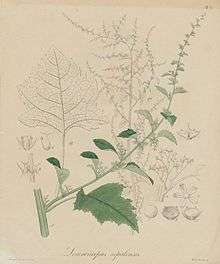Acroglochin
| Acroglochin | |
|---|---|
 | |
| Acroglochin persicarioides | |
| Scientific classification | |
| Kingdom: | Plantae |
| (unranked): | Angiosperms |
| (unranked): | Eudicots |
| (unranked): | Core eudicots |
| Order: | Caryophyllales |
| Family: | Amaranthaceae |
| Subfamily: | Betoideae ? |
| Genus: | Acroglochin Schrad. |
| Binomial name | |
| Acroglochin persicarioides (Poir.) Moq. | |
| Synonyms | |
|
see text | |
Acroglochin is a genus of flowering plants in the plant family Amaranthaceae, containing a single species, Acroglochin persicarioides. It is distributed from the Himalayas to China. The systematic position in subfamily Betoideae is still uncertain.
Description
Acroglochin persicarioides is an erect glabrous annual herb, 30-80 cm tall. The sparsely branched stems are ribbed and striate, green or purplish. The alternate leaves (up to 6 cm long) are long petiolate, their simple leaf blades are ovate to deltoid with irregularly and coarsely toothed margins.[1]
The inflorescences are numerous branched cymes in the axils of almost all leaves, erect-spreading, contracted, with short sterile branches ending needle-like. The hermaphrodite flowers are sessile, without bracts and bracteoles. The perianth is very small and consists of five basally connate tepals, these are linear-oblong, curved upwards, with a green center and membranous margins. There are one to three stamens and an ovary with short style and two short stigmas.[1]
The fruit is slightly shorter than the adpressed persistent perianth, and about 1-4 mm in diameter, it is disciform, depressed and saucer-shaped and opens circumscissile. The fruit wall (pericarp) is free. The horizontal seed is black, with a hard, thin, glossy seed coat. It contains an annular embryo and mealy perisperm (feeding tissue).[1]
The flowering and fruiting phase reaches from July to November.[2]
Distribution and habitat
Acroglochin persicarioides is distributed from the Himalayas (northern parts of Pakistan and India), Kashmir, Nepal, Bhutan, and Tibet to China[1] (Gansu, Guizhou, Hubei, S Hunan, Shaanxi, Sichuan, Yunnan)[2]
The plants grow in disturbed vegetation among rocks, on waste grounds, near cultivations,[1] at forest margins, riversides, open hillsides, or at roadsides.[2]
Systematics
The genus Acroglochin was first established in 1822 by Heinrich Schrader,[3] at the same time describing the single type species, Acroglochin chenopodioides. In the following years, several species of other genera were regarded as identical, especially Amaranthus persicarioides, which was already described in 1810, so that this name has priority. Alfred Moquin-Tandon published the combination Acroglochin persicarioides in 1849 as the accepted name for this species.[4]
Synonyms of Acroglochin are Lecanocarpus Nees and Blitanthus Rchb.. Synonyms of Acroglochin persicarioides are:
- Acroglochin chenopodioides Schrad. ex J.A. Schultes[1][2]
- Acroglochin persicarioides var. muliensis T.P. Soong[2]
- Acroglochin persicarioides var. multiflora T P. Soong[2]
- Acroglochin obtusifolia C.H.Blom[2]
- Acroglochin schraderiana Schult.f. ex Moq.[5]
- Amaranthus acroglochin Spreng.[5]
- Amaranthus diandrus Spreng.[5]
- Amaranthus cauliflorus Link[5]
- Amaranthus persicarioides Poir.[1][2]
- Blitanthus nepalensis Rchb.[5]
- Boehmeria amaranthus H.Lév.[6]
- Lecanocarpus cauliflorus (Link) Nees, T. Nees & Sinning
- Lecanocarpus nepalensis Nees[1]
Acroglochin was usually classified in subfamily Betoideae, because like all other Betoideae, the fruits are circumscissile capsules. But it proved to be phylogenetically isolated. The relationships are yet uncertain, it may probably be classified as a subfamily of its own.[7] Recent molecular research provides some evidence for the inclusion in subfamily Corispermoideae:[8]
References
- 1 2 3 4 5 6 7 8 Hedge, I.C. (1997). Acroglochin persicarioides. - In: Rechinger, K.H. et al. (Edit.): Flora Iranica 172, Chenopodiaceae: p.19. - Akad. Druck, Graz, ISBN 3-201-00728-5.
- 1 2 3 4 5 6 7 8 Zhu, G., Mosyakin, S.L., & Clemants, S.E.: Acroglochin persicarioides. In: Zhengyi, W., Raven, P.H., & Hong, D. (eds.): Flora of China. Volume 5: Ulmaceae through Basellaceae. Science Press/Missouri Botanical Garden Press, Beijing/St. Louis 2003, ISBN 1-930723-27-X, p. 353.
- ↑ Schrader, H.A. (1822). Mantissa in volumen primum systematis vegetabilium Caroli a Linné 1: 69. First description of Acroglochin
- ↑ Moquin-Tandon (1849). "Salsolaceae". in: De Candolle (ed.): "Prodromus Systematis Naturalis Regni Vegetabilis" 13(2), Masson, Paris: 254 First combination of Acroglochin persicarioides
- 1 2 3 4 5 "Acroglochin persicarioides". World Checklist of Selected Plant Families (WCSP). Royal Botanic Gardens, Kew. Retrieved 16 August 2016 – via The Plant List.
- ↑ Wilmot-Dear, C.M., Friis, I., Govaerts, R.H.A. (2014). "Nomenclatural corrections to the taxonomic revision of The Old World species of Boehmeria (Urticaceae, tribus Boehmerieae) by Wilmot-Dear & Friis (2013)". Blumea 59, 95–97. doi:10.3767/000651914X684691
- ↑ Kadereit, G., Hohmann, S. & Kadereit, J.W. (2006). "A synopsis of Chenopodiaceae subfam. Betoideae and notes on the taxonomy of Beta". - Willdenowia 36, p. 9-19.
- ↑ Romeiras, M.M., Vieira, A., Silva, D.N., Moura, M., Santos-Guerra, A., Batista, D., Duarte, M.C., & Paulo, O.S. (2016). "Evolutionary and Biogeographic Insights on the Macaronesian Beta-Patellifolia Species (Amaranthaceae) from a Time-Scaled Molecular Phylogeny." PLoS One. 2016; 11(3): e0152456. doi:10.1371/journal.pone.0152456
External links
 Media related to Acroglochin persicarioides at Wikimedia Commons
Media related to Acroglochin persicarioides at Wikimedia Commons Data related to Acroglochin at Wikispecies
Data related to Acroglochin at Wikispecies- Illustration of Acroglochin persicarioides at plantillustrations.org